Final report for FNC17-1100
Project Information
Stevens’ Farms is located in extreme Southeast Nebraska. The 1,300 acre operation is primarily row crop (corn and soybean rotation) with some native grass seed production. The farm has been mainly no-till for over 35 years and all hill ground is terraced and contour farmed. The principal operator, Dean Stevens, has 43 years of full-time farming experience. Dean’s wife and farming partner, Deb Stevens, along with their two daughters and son-in-law, actively contribute to the family operation. Dean also has a sport pilot license allowing him to aerially scout fields. Dean has been involved in the Nebraska Agriculture Technology Association and stays up to date with agriculture technology advances. For most of his farming career he has done his own field scale experimental plots evaluating: various crop hybrids, fertility, population, seed treatments and fungicide. For the last 8 years data from yield monitors has been used as an aid in management decisions. Recently Dean has experimented with in-season nitrogen (N) applications.
Yoesel Farms is a dairy and grain crop operation located in Southeast Nebraska. Dale and Ronda Yoesel have been involved in production agriculture for over 40 years including operating a century old family dairy. They practice sustainable crop production, routinely use dairy manure to fertilize crops, and plant and graze cover crops.
Applying a portion of the N fertilizer during the growing season, alongside the growing corn crop is one way to improve N management. In-season N applications allow N fertilizer availability and crop N uptake to be more closely matched and allow for N management which is responsive to current growing season conditions. Active crop canopy sensors have been used during the growing season to direct in-season N application and have been found to reduce N application and increase profit. This sensor technology is most commonly used on high clearance applicators, where sensing and application take place simultaneously. In southeast NE and other regions of the corn-belt, in-season N application by ground-based applicators is not common due to excessive crop damage in the rolling topography where contour and terrace farming practices are used. Some farmers in these landscapes rely on airplanes for in-season N applications. Additionally, small, passive, multi-spectral sensors can be carried on drones, enabling crop sensing to occur from the air. This study uses drone based sensing and aerial N application to demonstrate in-season N management which is conducted without vehicles on the ground in the field.
The goal of this research project is to:
- Evaluate the use of a passive crop canopy sensor to direct variable-rate, in-season N fertilizer recommendation rates on corn and apply this recommendation using variable-rate aerial technology.
- Evaluate different nitrogen pre-plant base-rates in combination with an in-season, variable-rate fertilizer system.
Cooperators
- (Educator)
Research
Applying a portion of the N fertilizer during the growing season, alongside the growing corn crop is one way to improve N management. In-season N applications allow N fertilizer availability and crop N uptake to more closely match and allow for N management which is responsive to current growing season conditions. Active crop canopy sensors have been used during the growing season to direct in-season N application and have been found to reduce N application and increase profit. This sensor technology is most commonly used on high clearance applicators, where sensing and application take place simultaneously. In southeast NE and other regions of the corn-belt, in-season N application by ground-based applicators is not common due to excessive crop damage in the rolling topography where contour and terrace farming practices are used. Some farmers in these landscapes rely on airplanes for in-season N applications. Additionally, small, passive, multi-spectral sensors can be carried on drones, enable crop sensing to occur from the air. This study uses drone based sensing and aerial N application to demonstrate in-season N management which is conducted without vehicles on the ground in the field.
The goal of this research project is to evaluate the use of a passive crop canopy sensor to direct variable-rate, in-season N fertilizer recommendation rates on corn and apply this recommendation using variable-rate aerial technology.
Year 1 (2017):
Determining the correct amount of N to apply as a base rate to provide the crop with enough N to reach the in-season N application is also critical. In year 1, the study evaluated two different N base rates to attempt to identify the optimum base rate for in-season sensing and application.
In 2017, there were three treatments at one research site (Figure 1):
- Farmer management - 160 lb N/ac + flat rate in-season N application if needed
- 75 lb/ac N base rate + in-season N management directed by drone
- 100 lb/ac N base rate + in-season N management directed by drone.
A high N reference received 225 lb N/ac in two smaller blocks.
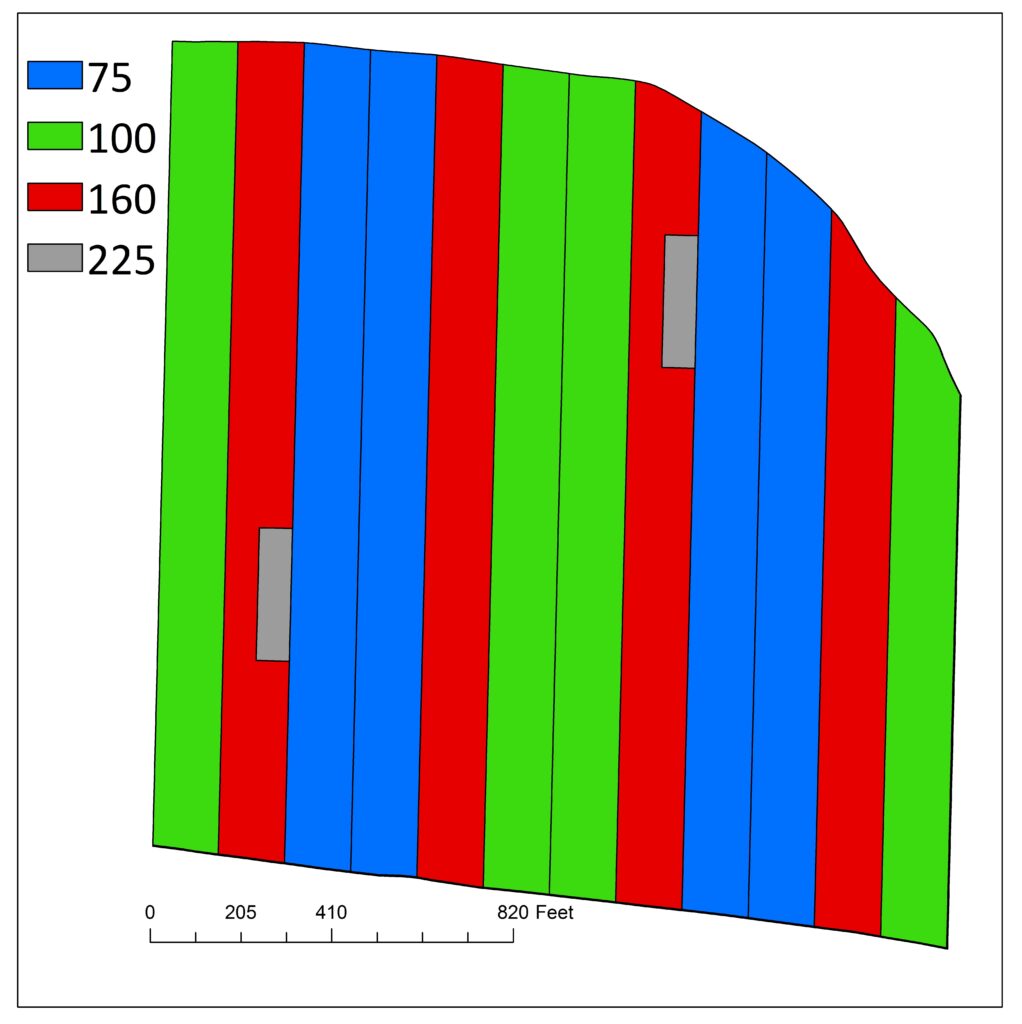
Pre-plant N was applied on February 15, 2017 as anhydrous ammonia. During the growing season, the field was flown with a DJI Inspire drone equipped with a MicaSense Red Edge 5 band sensor. Imagery was obtained on June 5, June 15, June 24, July 14, and September 4. The normalized difference red edge index (NDRE) was calculated for each flight. The NDRE index uses the near-infrared portion of the spectrum and allows differences in crop vegetation to be apparent, even when not visible in regular, true-color imagery (Figure 2). NDRE data was processed with unsupervised classification to remove pixels which are shadows and soil so that only plant pixels remain. A sufficiency index (SI) was calculated by dividing the NDRE of each pixel by the NDRE value of the top 5% of the field (virtual reference method). This allows each portion of the field to be compared to non-N limiting corn. NDRE data from the June 24 flight (Figure 2) was used to create an in-season, variable-rate prescription.
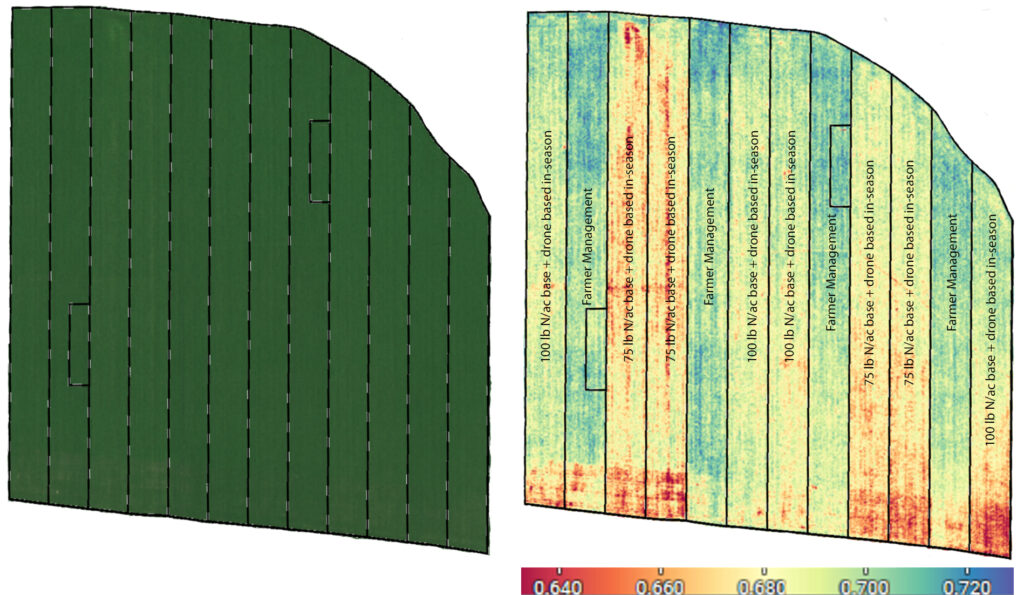
In-season N application was applied as stabilized urea (46% N) on June 29. Variable rate capabilities of the airplane dictated the length of a given rate be at least 200 ft and no more than 10 rates could be used. The in-season, variable-rate prescription is shown in Figure 3. The farmer elected to apply 40 lb N/ac to the farmer managed strips at this time.
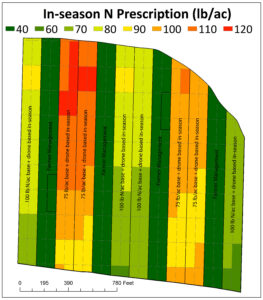
Year 2 (2018):
In 2018, we evaluated two treatments at two sites (Figure 4):
- Farmer management: 160 lb/ac N at site 1 and 180 lb/ac N at site 2.
- Drone management: 100 lb/ac N base rate + in-season N directed by drone and applied by airplane.
A high N reference received 225 lb N/ac in two smaller blocks.
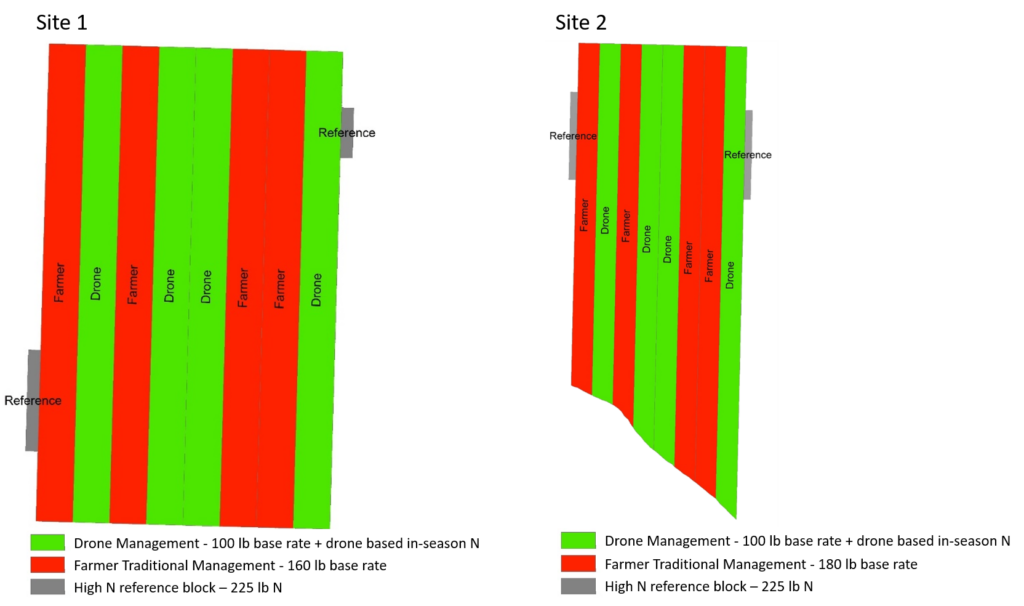
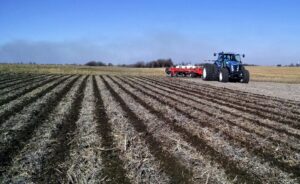
Pre-plant N was applied as anhydrous ammonia on November 30, 2017 at site 1 and December 1, 2017 at site 2. During the growing season, both sites were flown with a DJI Inspire 2 drone equipped with a MicaSense RedEdge 5 band sensor. Imagery was obtained on June 3, June 10, June 18, June 22, June 27, July 8, July 21, and August 9. The normalized difference vegetative index (NDVI) was calculated for the June 3 and June 10 flights. For the remaining flights, the normalized difference red edge index (NDRE) was used. The NDRE index uses the near-infrared portion of the spectrum and allows differences in crop vegetation to be apparent, even when not visible in regular, true-color imagery. A sufficiency index (SI) was calculated by dividing the NDRE of the target N application area by the NDRE value of the top 5% of the field (virtual reference method). This allows each portion of the field to be compared to non-N limiting corn.
NDRE data from the June 27 flight (Figure 5) was used to create an in-season prescription. Due to very similar N recommendation rates across the field, a variable rate application was not warranted. At site 1, the drone management strips received 25 lb/ac N as stabilized Urea (46%) on June 28 via airplane. The field received a 1.07" rainfall on June 30. At site 2, the drone management strips received 53 lb/ac N as stabilized Urea (46%) on June 28 via airplane. The field received a 0.45" rainfall on June 30. At both sites, the farmers elected to not apply any additional N in-season to their traditional management strips.
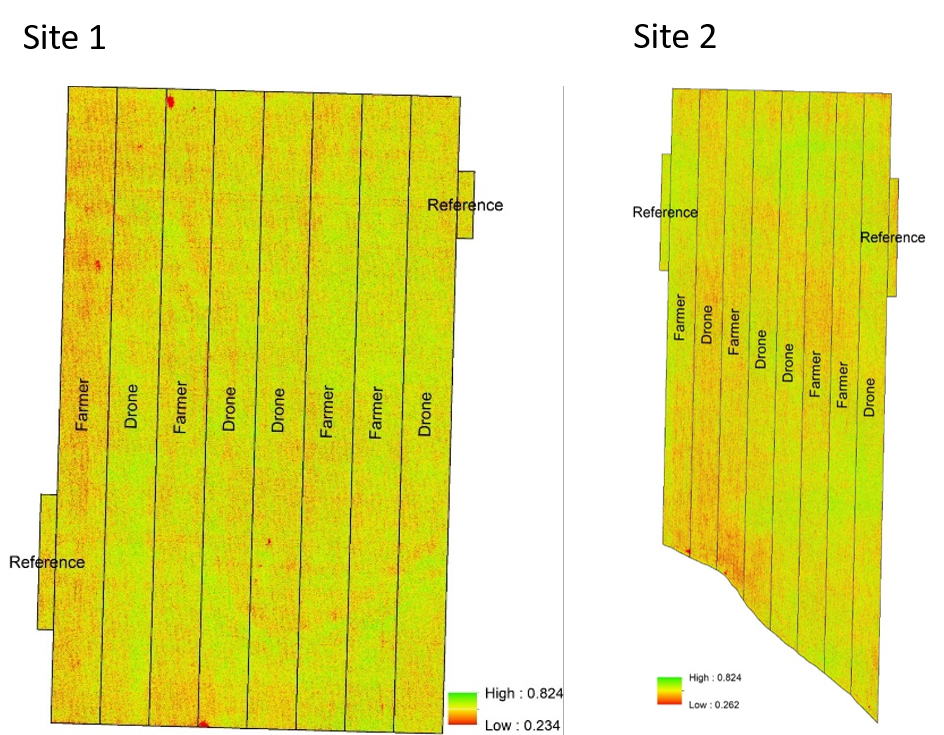
For all three sites, NDRE values from imagery prior to and after in-season N application were evaluated as well as final crop yield, nitrogen use efficiency, and net return.
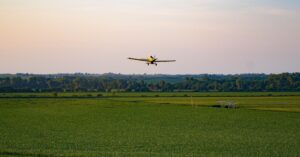
2017 Results:
The imagery collected before and after the in-season N application revealed that differences which existed prior to application were no longer present after N application. This suggests that following the in-season N application, the crop was able to recover from any N deficiency (Figure 6).
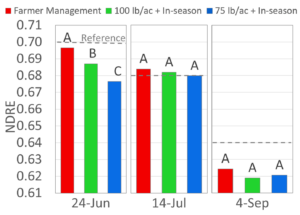
Table 1. Total N rate, moisture, test weight, yield, nitrogen use efficiency, and marginal net return for the farmer's traditional N management and two drone and sensor N management treatments for the 2017 research site.
|
|
Total N rate (lb/ac) |
Moisture (%) |
Test Weight |
Yield (bu/ac)† |
NUE (lb N/bu grain) |
Marginal Net Return‡ ($/ac) |
|
Farmer Traditional N Management |
200 |
15.2 A* |
60 A |
246.2 A |
0.81 A |
689.86 A |
|
Drone Management with 75 lb Base |
177 |
15.3 A |
60 A |
246.9 A |
0.72 A |
692.51 A |
|
Drone Management with 100 lb Base |
175 |
15.4 A |
60 A |
246.1 A |
0.71 A |
692.64 A |
|
P-Value |
N/A |
0.473 |
0.345 |
0.971 |
0.002 |
0.962 |
*Values with the same letter are not significantly different at a 90% confidence level.
†Yield values are from cleaned yield monitor data. Bushels per acre corrected to 15.5% moisture.
‡Marginal net return based on $3.15/bu corn, $465/ton anhydrous, $326.67/ton coated urea, $14/ac anhydrous application, $12/ac flat rate airplane application of urea, and $13.75/ac variable rate airplane application of urea.
2018 Results:
2018 was a very dry year with the entire growing season in D1 (moderate) to D2 (severe) drought.
Normalized difference red edge (NDRE) values from both the farmer and drone strips were very similar through much of the growing season (Figure 6 and 7).
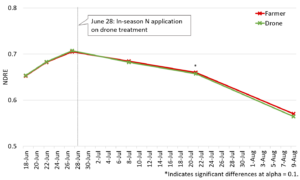
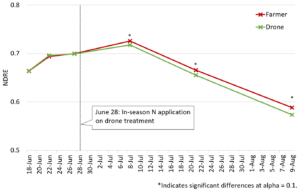
Table 2. Total N rate, moisture, test weight, yield, nitrogen use efficiency, and marginal net return for the farmer's traditional N management and the drone and sensor N management treatments for site one in 2018.
| Total N Rate (lb/ac) | Moisture (%) | Test Weight | Yield (bu/ac)† | NUE (lb N/bu grain) | Marginal Net Return‡ ($/ac) | |
| Farmer Traditional N Management | 160 | 15.9 A* | 59 A | 202.5 A | 0.79 A | 606.44 A |
| Drone N Management | 125 | 15.7 A | 60 A | 201.1 A | 0.62 B | 589.02 A |
| P-value | - | 0.212 | 0.295 | 0.667 | 0.001 | 0.175 |
*Values with the same letter are not significantly different at a 90% confidence level.
†Yield values are from cleaned yield monitor data. Bushels per acre corrected to 15.5% moisture.
‡Marginal net return based on $3.23/bu corn, $15/ac anhydrous application, $15.90/ac airplane urea application, $335/ton anhydrous, and $335/ton coated urea.
Table 3. Total N rate, moisture, test weight, yield, nitrogen use efficiency, and marginal net return for the farmer's traditional N management and the drone and sensor N management treatments for site two in 2018.
| Total N Rate (lb/ac) | Moisture (%) | Test Weight | Yield (bu/ac)† | NUE (lb N/bu grain) | Marginal Net Return‡ ($/ac) | |
| Farmer Traditional N Management | 180 | 17.1 A* | 58 A | 182.9 A | 0.99 A | 538.89 A |
| Drone N Management | 153 | 16.7 A | 58 A | 183.1 A | 0.84 B | 520.67 A |
| P-value | - | 0.205 | 0.231 | 0.947 | 0.002 | 0.128 |
*Values with the same letter are not significantly different at a 90% confidence level.
†Yield values are from cleaned yield monitor data. Bushels per acre corrected to 15.5% moisture.
‡Marginal net return based on $3.23/bu corn, $15/ac anhydrous application, $15.90/ac airplane urea application, $335/ton anhydrous, and $335/ton coated urea.
Summary:
- At all three sites, less nitrogen was applied when the drone and sensor method was used, than when the farmer's traditional method was used. Nitrogen savings for using the drone and sensor method were 25 lb N/ac, 35 lb N/ac, and 27 lb N/ac for the site in 2017, site 1 in 2018, and site 2 in 2018 respectively.
- At all sites, yield was not different between the drone and sensor method and the farmer's traditional method.
- At all sites, nitrogen use efficiency was greater for the drone and sensor method than for the farmer's traditional method.
- Profitability was similar between the treatments. In 2018, the cost of the second application added an additional cost compared to the farmer's method.
- It would be beneficial to see this method and technology in a wet year.
Educational & Outreach Activities
Participation Summary:
2017 Soils Tour Stop - June 7, 2017
Stevens Farms hosted a stop on the University of Nebraska Soils Tour of southeast Nebraska. Faculty and students learned about the process and implementation of their NCR SARE study, which aims at improved N use efficiency in sustainable corn production. Extension Educator Laura Thompson explained the use of a passive crop canopy sensor to direct variable-rate, in-season N fertilizer recommendation rates. Thompson outlined the protocol, which employs use of a sensor on board a drone to measure light reflected off the crop canopy from specific wavebands. These wavebands are used to calculate a normalized difference red edge index (NDRE) which is a means of determining the N status of the crop. These compact, lightweight sensors are attached to an unmanned aerial vehicle (UAV) to rapidly and frequently monitor crop NDRE. The presentation generated much discussion and increased the awareness of this cutting-edge technology.
In conjunction with the presentation, a handout was shared that reported normalized yield data, soil types, treatments, and imagery from a June 5, 2017 drone flight. Sare_Project_Handouts_Soils_Tour
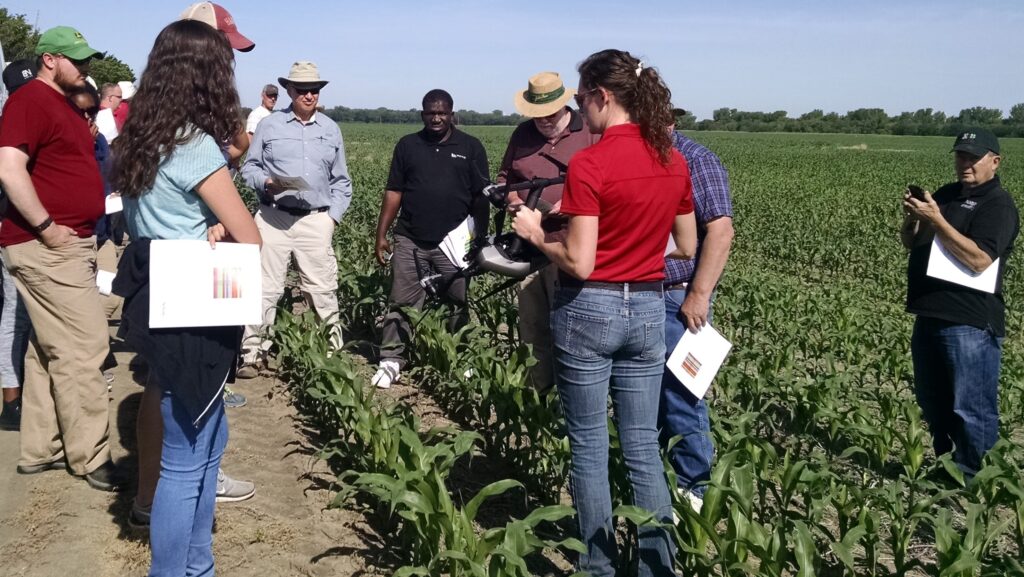
IANR Crop Watch Features SARE Project - October 2017
The University of Nebraska Crop Watch Editor, Lisa Jasa, interviewed Dean and Debra Stevens about the application and implementation of their NCR SARE grant project. The interview is posted at:
https://cropwatch.unl.edu/2017/sare-grant-aids-farmers-using-drones-test-n-applications
Nebraska Farmer Features SARE Project - December 2017
The Nebraska Farmer featured the article written by Lisa Jasa, Nebraska Crop Watch Editor.
http://www.nebraskafarmer.com/technology/sare-grants-help-farmer-use-uas-test-n-applications
Midwest Messenger - October 2017
Midwest Messenger featured the article written by Lisa Jasa, Nebraska Crop Watch Editor.
Annual Meeting of the American Society of Agronomy - October 23, 2017
Laura Thompson delivered a poster presentation featuring the first year project results. There was excellent interest in the project with constant traffic stopping by to visit about the project for over 2 hours. Approximately 35 individuals learned about the project.
Nebraska On-Farm Research Network 2017 Growing Season Results - available online
The results of year one of the study were published in the annual Nebraska On-Farm Research report available online.
https://cropwatch.unl.edu/OnFarmResearch/2017GrowingSeasonResults.pdf
York, Nebraska Ag Expo - January 11, 2018
Laura Thompson presented year one of this research project as part of a presentation titled "Precision Agriculture."
Wilbur, Nebraska Crop Clinic - February 16, 2018
Laura Thompson presented year one of this research project as part of a presentation titled "Nebraska Extension On-Farm Research Update."
2018 On-Farm Research Annual Growing Season Results Update Meeting - February 19, 20, 21, 27, and 28, 2018
The results of year one of the study were presented at the annual Nebraska On-Farm Research Network Update Meetings held in 5 locations across the state. 162 attended these meetings.
International Conference on Precision Agriculture - June 27, 2018
Laura Thompson delivered a poster presentation featuring the first year project results at this conference in Quebec, Montreal, Canada. There was excellent interest in the project with constant traffic stopping by to visit about the project for over 2 hours. 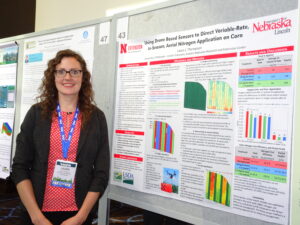
UNL Extension Educator Laura Thompson shares SARE project results in Montreal.
Nebraska Farmer Article - July 4, 2018
The Nebraska Farmer featured this project in an article written by Tyler Harris, Nebraska Farmer Editor.
https://www.farmprogress.com/aerial-imagery/precision-ag-takes-flight
2018 Field Day - July 19, 2018
Dean & Deb Stevens hosted an on-farm field day on July 19, 2018 to update the ag sector in the use of drones for corn nitrogen management. The field day aimed to help local farmers increase nitrogen use efficiency, assess cutting-edge technologies and improve management techniques. 64 people attended.
The entire field day was recorded allowing those who were not able to attend in person to access this information: Field Day Video on YouTube
The event opened with Gary Lesoing, Extension Educator & Nebraska State SARE coordinator reviewing resources and grants available to farmers through the SARE Program. Laura Thompson, Nebraska On-Farm Research Network & Ag Technology Extension Educator, along with Dean Stevens presented the progress from 2017 and 2018 in using drone based sensors for variable rate aerial nitrogen application on corn.
John Lueger, representing Heinen Brothers Agri Services of Seneca, KS provided an overview of variable rating nitrogen from an aerial perspective. As their GIS/Contract Specialist, John had first hand knowledge of both the advantages and challenges of this method of nitrogen application.
Nathan Thompson, an FAA licensed drone pilot, spoke about the requirements needed to pilot a drone, the type of drone and camera system he used for this SARE study, the mapping software, and challenges related to recording corn fields during a typical growing season. A highlight of his presentation was a live demonstration using the drone system involved with this project. Participants were able to view his flight path on a large screen as he piloted the drone. There was excellent interest in this segment of the program.
The on-farm field day received excellent support and funding from F&M Bank of Falls City, Nebraska; Farm Credit Services of America; Nebraska Extension; and Yoesel Dairy. Refreshment breaks and lunch were provided and underwritten by these cooperators.
To promote the event, area businesses and media outlets used this flyer: Field Day Flyer.
200 direct mail postcards were sent to a targeted audience: Direct Mail Postcard.
A website was created to provide additional information and directions to the farm: https://tinyurl.com/drone18
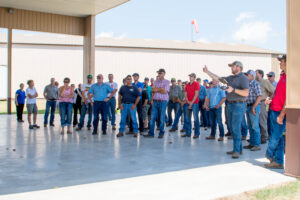
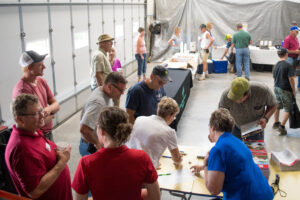

Northwest Missouri Certified Crop Advisers Conference - January 22, 2018
Laura Thompson presented year one and two of the research to approximately 150 attendees of this conference.
Nebraska On-Farm Research Network 2017 Growing Season Results - available soon
The results of year two of the study will be published in the annual Nebraska On-Farm Research report available online.
NCR-SARE Farmers Forum as part of the Nebraska Sustainable Agriculture Society (NSAS) Annual Conference, February 8-9th, 2019, Grand Island, NE Dean Stevens and Nathan Thompson will be speakers at this event, and will highlight results of the two year study.
2019 On-Farm Research Annual Growing Season Results Update Meeting - February 18, 19, 20, 26, and 27, 2019
The results of year two of the study will be presented at the annual Nebraska On-Farm Research Network Update Meetings to be held in 5 locations across the state including, Grand Island, Norfolk, Beatrice, North Platte, and Alliance.
Farm Futures Magazine - Spring 2019
The results of this research project are scheduled to be included in an article on in-season nitrogen management in a spring edition of Farm Futures.
Learning Outcomes
- Drone sensors can be used successfully to monitor corn nitrogen needs in-season. The varying nitrogen requirements can be met on entire corn fields with variable rate equipped planes. This is an excellent way to avoid pre-applying more nitrogen than a corn crop would be able to utilize if conditions became unfavorable during the pending growing season.
- Lower N rate did not cause yield loss. Nitrogen Use Efficiency was improved and excellent NUEs can be obtained.
- The technology used is new and rapid changes occurred during our study – this was a challenge. Software and sensor options are still rapidly changing. Hopefully this will improve in the near future. Also, being ready to fly the drone at a moment’s notice as favorable weather occurs, is essential to capture viable images. In spite of these drawbacks we will likely continue to look for ways to improve our ability to gather usable drone data to be better stewards with nitrogen applications.
- In a non-irrigated environment there are risks and challenges with delaying part of the corn’s nitrogen needs to aerial in-season application. Without a timely incorporating rain, part of the sidedressed nitrogen can be lost, even with stabilized urea nitrogen.
- We did not assign a cost for the time it takes to fly a field with the drone. More work is needed to determine a cost for this factor and help determine if this is cost effective.
- There are several follow up research questions which could be addressed based on this project:
- Method of determining N rate – virtual reference vs actual reference. While we used a virtual reference concept, our data collection provides some evidence that even greater nitrogen savings could be attained by using an actual reference method. This concept could be further researched.
- It would be advantageous to see this project in a wetter year. More benefit may be realized due to various amounts of nitrogen lost across a field because of different soil types and topographies. Additionally, the split application method may provide additional benefits, as there would be less N initially on the field, and therefore less N would be lost in wet conditions. This would provide additional environmental benefits.
- Center pivot irrigators may want to evaluate this method of nitrogen management to monitor corn nitrogen status and determine whether or not to fertigate. This may be a good fit with less risk and excellent potential for N savings.
Project Outcomes
At the field day held on July 19, 2108 we surveyed attendees to document the impact of our educational effort.
64 people attended; 67% were farmers, 15% were crop consultants or agronomists, 11% identified as other, and 7% were agribusiness representatives.
- 96% of respondents had moderate or significant knowledge gain regarding sensor and drone field data collection.
- 92% of respondents had moderate or significant knowledge gain regarding sensor-based nitrogen application.
- 80% of respondents plan to start or expand use of sensor based systems for in-season N applications.
- 64% of respondents plan to start or expand use of split nitrogen application.
- 48% of respondents were likely or very likely to start using drones on their farm or in their business.
- 32% of respondents were likely or very likely to contract with others to collect imagery with drones.
Respondents estimated the value of the knowledge they gained in terms of anticipated practice changes at $5.60/ac.
Selected comments from attendees:
"I have a drone and have been looking for ways to implement it in agriculture. This training has helped me learn about the process."
"Fantastic field day!"
At the Nebraska On-Farm Research Network Annual Results Update in February 2018, of 162 attendees, 82% reported learning new information about in-season N management and 49% said they would make adjustments to improve their N management strategies.
Additionally, three farmers were interested in using drones and sensors for managing nitrogen and we worked with them to implement this technology in some aspect.